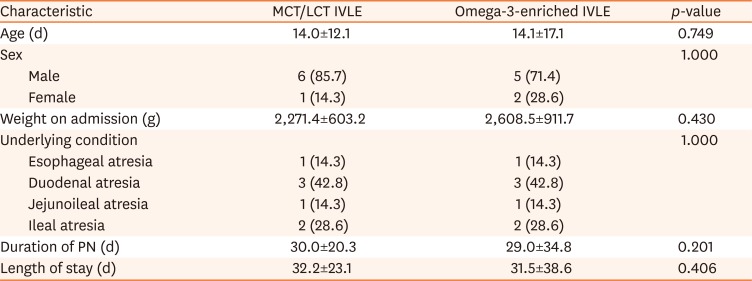1. Wang J, Yu JC, Kang WM, Ma ZQ. Superiority of a fish oil-enriched emulsion to medium-chain triacylglycerols/long-chain triacylglycerols in gastrointestinal surgery patients: a randomized clinical trial. Nutrition. 2012; 28:623–629. PMID:
22113064.

2. Ammoury RF, Croffie JM. Malabsorptive disorders of childhood. Pediatr Rev. 2010; 31:407–415. quiz 415-6. PMID:
20889735.

3. Skillman HE, Wischmeyer PE. Nutrition therapy in critically ill infants and children. JPEN J Parenter Enteral Nutr. 2008; 32:520–534. PMID:
18753390.

4. Chawla BK, Teitelbaum DH. Profound systemic inflammatory response syndrome following non-emergent intestinal surgery in children. J Pediatr Surg. 2013; 48:1936–1940. PMID:
24074671.

5. Buchman A. Total parenteral nutrition-associated liver disease. JPEN J Parenter Enteral Nutr. 2002; 26(5 Suppl):S43–S48.

6. Mullick FG, Moran CA, Ishak KG. Total parenteral nutrition: a histopathologic analysis of the liver changes in 20 children. Mod Pathol. 1994; 7:190–194. PMID:
8008742.
7. Grau T, Bonet A, Rubio M, Mateo D, Farré M, Acosta JA, et al. Working Group on Nutrition and Metabolism of the Spanish Society of Critical Care. Liver dysfunction associated with artificial nutrition in critically ill patients. Crit Care. 2007; 11:R10. PMID:
17254321.
8. Pereira-da-Silva L, Nóbrega S, Rosa ML, Alves M, Pita A, Virella D, et al. Parenteral nutrition-associated cholestasis and triglyceridemia in surgical term and near-term neonates: A pilot randomized controlled trial of two mixed intravenous lipid emulsions. Clin Nutr ESPEN. 2017; 22:7–12. PMID:
29415837.

9. Kasirer Y, Bin-Nun A, Raveh A, Schorrs I, Mimouni FB, Hammerman C. SMOFlipid protects preterm neonates against perinatal nutrition-associated cholestasis. Am J Perinatol. 2019; 36:1382–1386. PMID:
30620942.

10. Koletzko B, Goulet O, Hunt J, Krohn K, Shamir R. Parenteral Nutrition Guidelines Working Group. European Society for Clinical Nutrition and Metabolism; European Society of Paediatric Gastroenterology, Hepatology and Nutrition (ESPGHAN); European Society of Paediatric Research (ESPR). Guidelines on paediatric parenteral nutrition of the European Society of Paediatric Gastroenterology, Hepatology and Nutrition (ESPGHAN) and the European Society for Clinical Nutrition and Metabolism (ESPEN), supported by the European Society of Paediatric Research (ESPR). J Pediatr Gastroenterol Nutr. 2005; 41(Suppl 2):S1–S87.
11. Wu MH, Wang MY, Yang CY, Kuo ML, Lin MT. Randomized clinical trial of new intravenous lipid (SMOFlipid 20%) versus medium-chain triglycerides/long-chain triglycerides in adult patients undergoing gastrointestinal surgery. JPEN J Parenter Enteral Nutr. 2014; 38:800–808. PMID:
24285251.

12. Ma CJ, Wu JM, Tsai HL, Huang CW, Lu CY, Sun LC, et al. Prospective double-blind randomized study on the efficacy and safety of an n-3 fatty acid enriched intravenous fat emulsion in postsurgical gastric and colorectal cancer patients. Nutr J. 2015; 14:9. PMID:
25609264.

13. Jiang W, Chen G, Zhang J, Lv X, Lu C, Chen H, et al. The effects of two mixed intravenous lipid emulsions on clinical outcomes in infants after gastrointestinal surgery: a prospective, randomized study. Pediatr Surg Int. 2019; 35:347–355. PMID:
30474700.

14. Diamond IR, Sterescu A, Pencharz PB, Wales PW. The rationale for the use of parenteral omega-3 lipids in children with short bowel syndrome and liver disease. Pediatr Surg Int. 2008; 24:773–778. PMID:
18504595.

15. Costa S, Iannotta R, Maggio L, Barone G, Serrao F, Vento G. Fish oil-based lipid emulsion in the treatment of parenteral nutrition-associated cholestasis. Ital J Pediatr. 2018; 44:101. PMID:
30139361.

16. Carpentier YA, Simoens C, Siderova V, el Nakadi I, Vanweyenberg V, Eggerickx D, et al. Recent developments in lipid emulsions: relevance to intensive care. Nutrition. 1997; 13(9 Suppl):73S–78S. PMID:
9290113.

17. Wiik H. Inflammatory response following abdominal surgery and its modulation by recombinant human granulocyte colonystimulating factor (rhg-csf, filgrastim) [Internet]. Oulu: Oulu University Press;2002. cited 2017 Dec 18. Available from:
http://jultika.oulu.fi/files/isbn9514268474.pdf.
18. Hallay J, Olah AV, Fulesdi B, Kocsor M, Vegh T, Kovacs G, et al. Hepatobiliary response in postoperative lipid therapy in gastrointestinal surgery. Hepatogastroenterology. 2010; 57:1069–1073. PMID:
21410033.
19. Berger MM, Tappy L, Revelly JP, Koletzko BV, Gepert J, Corpataux JM, et al. Fish oil after abdominal aorta aneurysm surgery. Eur J Clin Nutr. 2008; 62:1116–1122. PMID:
17538537.

20. Shearer GC, Savinova OV, Harris WS. Fish oil -- how does it reduce plasma triglycerides? Biochim Biophys Acta. 2012; 1821:843–851. PMID:
22041134.









 PDF
PDF ePub
ePub Citation
Citation Print
Print



 XML Download
XML Download